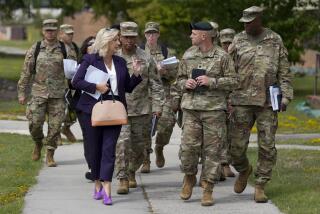Army is stretched too thin
- Share via
WASHINGTON — The Army’s top general said Thursday that the mission in Iraq “will break” the Army without an expansion of the size of the active-duty force or the remobilization of the National Guard and reserves.
Gen. Peter J. Schoomaker, the Army chief of staff, said the all-volunteer Army was being tested by a schedule that allowed less than a year at home for active-duty units between deployments to Iraq.
Boosting the size of the active-duty force would be expensive, and remobilizing the guard members and reservists who have already served in Iraq would be controversial and politically unpopular. But the high operational demand placed on the Army is unlikely to end soon, Schoomaker said. And without sending reservists to Iraq for additional tours or expanding the size of the active-duty Army, it would be difficult to meet the overseas demands.
The Army is officially allowed to have 482,000 soldiers, but Congress has temporarily authorized the service to grow by 30,000. So far, the Army has added 25,000 soldiers.
Testifying before the Commission on the National Guard and Reserves, which was created by Congress to examine challenges facing the reserve component, Schoomaker did not say precisely how much he wanted the Army to grow. But he said “current demand” made an increase “wise and prudent.” His remarks left open the possibility that the Army would seek an increase beyond its current limit of 512,000.
“If the nation decides to further increase the size of the Army, it will take a significant amount of time and commitment from the nation,” he said. “Optimistically, we could add 6,000 to 7,000 soldiers per year.”
Last month, Marine Gen. James T. Conway said that an increase in his force was under consideration and that funding for a temporary boost in the size of the Corps could be included in next year’s supplemental budget request.
Some outside experts -- notably Frederick W. Kagan of the conservative American Enterprise Institute think tank in Washington -- have suggested that the Army should grow annually by one division, about 20,000 people, until it reaches 750,000 soldiers.
Kagan said that from 1979 to 1991, America had an all-volunteer active-duty force of 780,000. “I do not believe we cannot find a way to recruit to a higher level,” he said. “The president is going to have to call on the young people of this nation to come out and support this effort.”
Such growth is possible, other experts say, but during an unpopular war, it would require large bonuses and pay increases that would eat into the military budget.
Kagan has proposed building up the Army in part to allow the military to send additional forces to Iraq.
In a proposal outlined Thursday, Kagan said that by speeding up rotations and extending tours, the Army and Marine Corps could add some 30,000 combat troops in 2007.
Army officials’ estimates of how many soldiers they could add are much lower.
Army officials have been talking privately for months about the need to send guard and reserve units for second tours. But Schoomaker’s remarks were the most forceful public presentation yet about the need to tap the reserves further.
Typically reservists must be mobilized for at least 18 months in order to serve in Iraq: six months to train and a year to serve in the war zone. Under current practice, the National Guard and reserves can be mobilized for only a single tour in Iraq. But Schoomaker said almost all of the reserve units had been called once since Sept. 11, 2001.
In early 2005, about 40% of the force in Iraq was made up of Guard troops and reserves. But because numerous soldiers and units have been mobilized, the Army has had to fill out units with volunteers from across the country who are willing to serve a second tour.
The Army wants to be able to send units to Iraq that have trained together, even if some of their members have already served an overseas tour.
“In my view we must deploy our force in cohesive units, not as individual soldiers,” Schoomaker said. “This will require us to remobilize units and reserve component soldiers.”
Army officials believe under the law they are allowed to remobilize reservists for a second tour.
Top Pentagon officials have not yet allowed such involuntary remobilizations, but the policy is being examined by the Commission on the National Guard and Reserves.
More to Read
Sign up for Essential California
The most important California stories and recommendations in your inbox every morning.
You may occasionally receive promotional content from the Los Angeles Times.













